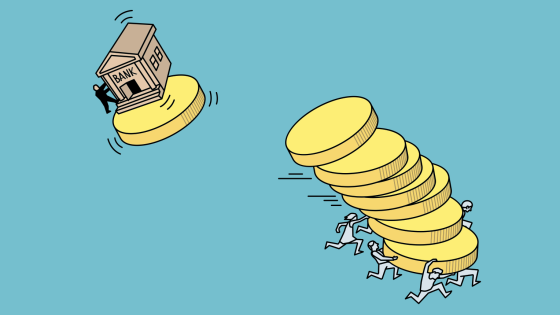Many academic papers about the Great Recession in the US have focused on the boom-bust in housing wealth and how it affected spending of the middle class. But there are reasons to think that a large role was actually played by the rich, as they responded to developments in their overall wealth.
According to the traditional narrative, the rich play a role but as generators of ‘excess saving’ (Kumhof et al. 2013) and not as part of the spending boom-bust. In the 1980s, incomes of the high-saving rich soared, while those of the middle class stagnated. So the rich lent their ‘increased’ savings to the middle class, who used the funds to maintain their consumption growth (Rajan 2010) and speculate in real estate. Initially, all was well, as the real estate boom propelled a construction-based expansion. But by 2007, the music had stopped. The middle class became overextended and ceased buying houses, causing prices to collapse so sharply that many homeowners were plunged ‘underwater’ on their mortgages, owing more than their houses were worth. Some defaulted, while others rapidly increased their saving rates so they could pay down their debts (Mian and Sufi 2014). The result was a deep recession.
In a recent paper (Bakker and Felman 2014) we argue that:
- It was not just the drop in housing wealth that made the Great Recession so deep, but also the decline in financial wealth. The decline in total wealth was key to explaining the depth of the recession, not the decline in housing wealth only.
- The rich were not merely passive spectators, generating excess saving to finance the middle class, but active participants in the consumption boom-bust cycle. The saving rate of the rich actually went through a similar cycle as that of the middle class, as rising wealth first spurred their consumption and then falling wealth restrained it. And as the rich accounted for such a large share of aggregate income, this cycle had a profound impact on overall consumption.
Wealth losses and the Great Recession
Wealth effects played a key role in the pre-crisis drop and post-crisis surge of the household saving rate (Figure 1). Asset prices surged during the boom years, boosting consumption and fuelling a drop in the saving rate. When asset prices collapsed during the crisis, wealth effects went into reverse, leading to drop in consumption (Case et al. 2011).
Figure 1. Household net worth and saving rate (% of disposable income)

Note: In this figure, net worth in year t is the average of net worth at the end of year t-1 and the end of year t.
Wealth effects also help explain why the housing market crash was so much more severe than the dotcom bust. Mian and Sufi (2014) have argued that housing assets are special. Acquisition of real estate, unlike purchases of financial assets, is largely funded by borrowing and this explains why the Great Recession was so much more severe than the dotcom bust, even though the housing market losses in the former were about the same as the stock market losses in the latter. A simpler explanation may be that the dotcom bust was mitigated by an increase in nonfinancial assets (mostly housing) while the housing market crash was exacerbated by the drop in financial assets (Figure 2), which actually accounted for $8 trillion of the $13 trillion in peak-to-trough losses in wealth.
Figure 2. Change in assets, dotcom bust vs housing crash (Trillions of US dollars)

The saving rate of the rich
Many papers have assumed that the saving rate of the rich remained very high during the boom years. This is consistent with the Consumer Expenditure Survey (CEX), which shows that the saving rate of the top quintile averaged 33% during the 2000s, compared with 21% during the 1990s.
However, data in the CEX are not consistent with the National Income and Product Accounts (NIPA). According to the CEX, the aggregate household saving rate increased before the Crisis, by a considerable amount. This is at odds with the NIPA data (Figure 3) which show that household saving rates plummeted before the Crisis, from 8.9% in 1992 to 2.5% in 2005. It is well-known in the literature that the CEX data underreport consumption, particularly among the well-off; and this underreporting has increased over time. As a result, the apparent rise in the saving rate may simply represent an increased underreporting of consumption.
Figure 3. Household saving rate: National accounts vs CEX

If we use the NIPA data we don't have figures on saving by income class. But we can nonetheless figure out what must have happened to saving rates of the rich and the middle class. We have to explain why the aggregate household saving rate declined in the pre-crisis years, even as there was a shift in income distribution towards the (presumably) high-saving rich. The standard explanation is that the reduction in saving by the middle class outweighed the rise in the saving of the rich.
In our view, the more likely explanation was that the reduction in middle class saving was accompanied by a decline in the saving rate of the rich. If the saving rate of the rich had remained constant, it is difficult to explain why the correlation between distribution and (NIPA-measured) saving over the past three decades has been strongly negative––the greater the income share of the rich, the lower aggregate saving (Figure 4). By contrast, if the saving rate of the rich has trended down, this could have offset the impact of the shift in income toward the rich on the aggregate saving rate. The flow of funds shows that before the Crisis the debt of the rich actually increased as rapidly as that of the middle class (Figure 5).
Figure 4. Income share top 10% and household saving rate

Figure 5. US: Average household debt

But why would the rich have reduced their saving rate, even at a time when their incomes were rising rapidly? They were responding to the surge in their wealth. The wealth-to-income ratio of the top 10% soared from 721% in 1994 to 912% in 2007. By contrast, the wealth-to-income ratio of the bottom 90% increased from 373 to 404% only (Figure 6).
Figure 6. Wealth-to-income ratios top10 and bottom 90

The role of the rich
If the saving rate of the rich followed the same cycle as that of the middle class, then the rich must have played a key role in driving the consumption boom-bust because they were the group that received the bulk of the income and wealth gains during this period (Figure 7).
Figure 7. US: Net worth and income of bottom 90 and top 10

To demonstrate this empirically, we use a consumption function that incorporates elements of both the inequality and the wealth narratives. In line with the inequality narrative, we assume that the marginal propensity to consume income for the rich is lower than that of the poor. At the same time, we assume that consumption also depends on wealth.
We specify the consumption function in log terms:
LOG (Ct) = a ßrlOG(Ytr) + ßmlOG(Ytm) + y LOG(Wt)
We estimate the model using annual data for the US for 1990-2013. The estimated model fits the data well, and the estimated parameters are broadly in line with the literature:
- The elasticity of (total) consumption with respect to middle class income is 0.58, which implies a marginal propensity to consume of 95%. The elasticity of consumption to the income of the rich is 0.33, which translates to a marginal propensity to consume of 65%.
- The implied marginal propensity to consume out of wealth is 2.2%, compared to standard estimates ranging from 2 to 6%.
Next, we use the model to calculate the role of the rich in driving consumption. We would expect a significant role, simply because their income and wealth gains have been so much larger than those of the middle class.
The model suggests something truly striking. The top decile explains the bulk of overall consumption growth (Figure 8). Between 2003 and 2013, about 71% of the increase in consumption came from the rich. Much of the slowdown in consumption between 2006 and 2009 was the result of a drop in consumption of the rich. The rich also played a key role in the subsequent recovery.
Figure 8. The top 10 and bottom 90: Contribution to change in consumption from 1990

Conclusion
Our results suggest that the standard narrative of the Great Recession may need to be adjusted. Housing played a role, but so did financial assets, which actually accounted for the bulk of the loss in wealth. The middle class played a role, but so did the rich. In fact, the rich now account for such a large share of the economy, and their wealth has become so large and volatile, that wealth effects on their consumption have started to have a significant impact on the macroeconomy. Indeed, the rich may have accounted for the bulk of the swings in aggregate consumption during the boom-bust.
Disclaimer: The views expressed in this blog are those of the authors and do not necessarily represent the views of the IMF, its Executive Board, or IMF management.
References
B B Bakker and J Felman (2014), “The Rich and the Great Recession”, IMF Working Paper WP/14/225.
Case, K E, J M Quigley, and R Shiller (2011), “Wealth Effects Revisited, 1978–2009”, Cowles Foundation Discussion Paper No 1784.
Kumhof, M, R Ranciere, and P Winant (2013), “Inequality, Leverage and Crises: The Case of Endogenous Default”, IMF Working Paper WP/13/249.
Mian, A and A Sufi (2014), House of Debt, The University of Chicago Press.
Rajan, R (2010), Fault Lines: How Hidden Fractures Still Threaten the World Economy, Princeton University Press.











